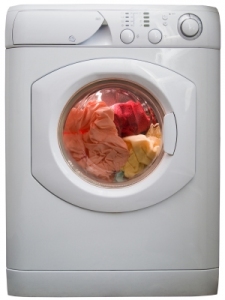 If you have already switched to an eco-friendly laundry detergent, as many people do to contribute less to water pollution, you might be surprised to learn that the pollution you generate on wash day has as much to do with the kind of fabrics your clothes, bedding and towels are made of as the detergent you wash them in.
If you have already switched to an eco-friendly laundry detergent, as many people do to contribute less to water pollution, you might be surprised to learn that the pollution you generate on wash day has as much to do with the kind of fabrics your clothes, bedding and towels are made of as the detergent you wash them in.
Recent studies have revealed that a single garment made of polyester can shed innumerable tiny fibers into the wash water, and those fibers are finding their way to the ocean. The pollution they cause is worsened by the fact that, like plastic materials in general, polyester attracts oily pollutants in seawater so is a vehicle for the transfer of potentially dangerous chemicals into the food web when the fibers are ingested by sea creatures.

Although we don’t usually think of polyester fabrics as plastic per se, polyester is nonetheless a plastic material synthesized from crude oil and natural gas. And, like other plastics, polyester is a long polymer chain, making it non-biodegradable in any practical human scale of time, especially in the ocean because of the cooler temperatures.
Particular attention to ocean pollution from plastics has intensified ever since the late ‘90s when Captain Charles Moore of the Algalita Marine Research Foundation based in California first trawled a now infamous Texas-sized area of the Pacific Ocean dubbed the “great Pacific garbage patch” to quantify the extent of plastic pollution. The startling discovery at that time was that plastic debris already outweighed zooplankton (organisms at the base of the ocean food web) by a factor of six to one. Moore just revisited the same area last year and reports that the ratio of plastic debris to zooplankton has increased six-fold in under a decade.
When we reflect on ocean pollution from plastics, we tend to think of larger eyesores of plastic debris, like plastic bags, foam cups, abandoned fishing nets and drink bottles & caps. It’s already well-documented that many fish, seabirds, turtles and marine mammals die each year because of ingestion or entanglement in such obvious plastic refuse. But when exposed to sunlight and other environmental stresses, plastics break apart into smaller scraps which, nevertheless, remain as a plastic polymer and non-biodegradable. Once fragmented into bits less than one millimeter (the size of a pin head), they are called “microplastics.”
The breakdown of larger plastics is not the only known source of microplastics pollution. Two others have been identified in the sewage stream: tiny plastic granules, used in beauty products and cleaning agents as scrubbers, and spillage of plastic powders and pellets which are the industrial raw materials for fabricating consumer plastics. Microplastic fibers of an unknown source are also showing up in the sewage stream. Because waste treatment plants are not designed to filter out microplastics, any that enter the sewage stream end up in the ocean and anywhere else the outflow from waste treatment plants is dumped.
Though invisible to the casual observer, microplastics are accumulating throughout marine habitats, and research is showing that they already outnumber larger plastic fragments. For example, one study sampling a British estuary – where the ocean tide meets a river’s end – found that microplastics accounted for 65 percent of all plastic debris.
Although it might seem counterintuitive, the tiny dimension of microplastics actually adds to the dangers they represent as ocean pollutants. Since a pioneering study published in 2001, we’ve known that, because plastics are lipophylic (oil-loving), oily contaminants in seawater are drawn to them. Japanese researchers found that plastic pellets no more than a half millimeter in diameter could adsorb hazardous chemicals (like polychlorinated biphenyls, nonylphenols and derivatives of DDT) onto their surfaces at up to one million times the concentrations in the surrounding water. The kicker about microplastics is that, because of their smallness, the surface area is large relative to the overall size, providing more surface area to which chemicals can adhere: Think of a bottle filled with marbles – the total surface area of all the marbles is greater than the surface area of the bottle.
And, the miniscule size of microplastics means that even minute creatures could ingest them, either by accident or by mistaking them for food, thereby introducing any chemicals on board into the very bottom of the food chain. Adding to this worry, plastics themselves are generally complex substances with several chemical additives, some with known negative health effects in lab animals and humans. Scientists have already documented ingestion of microplastics by little ocean critters like sandworms, barnacles and small crustaceans called amphipods. Research has also shown that, once ingested by animals, microplastics are stored in tissues and cells with unknown health consequences for both the animals and us eating up at the top of the food chain.
Another obvious downside to microplastics is that their size makes them utterly impossible to clean up once they get into the ocean, or any other environment for that matter.
What all this has to do with polyester fabrics on wash day is pretty straightforward. Polyester cloths are used in innumerable items routinely laundered at home, such as blankets, towels and every sort of garment. They are by design composed of tiny plastic fibers, so on a hunch that polyester fibers from laundering are a major source of the microplastic fibers polluting ocean habitats, a team of researchers from the British Isles, Canada and Australia measured the quantity of microplastic fibers from polyester blankets, shirts and fleeces that are discharged into the wastewater from domestic washing machines. As reported in the November 1 issue of the journal Environmental Science & Technology, a single polyester item can produce more than 1900 fibers in one washing. Every article tested produced more than 100 microfibers per liter of wastewater, and the worst offenders were the fleeces.
The researchers also provided strong evidence linking polyester from laundering to ocean pollution. They found that every one of 18 shorelines sampled across the globe was fouled with microplastic fibers, predominantly of polyester. The shorelines of more densely populated areas or where sewage is discharged were the most contaminated. Furthermore, by characterizing the microplastics in the outflow of sewage treatment plants, they were able to show that polyester fibers from laundering were the prime source of microplastic pollution in general, more than from fragmentation of larger plastics or from cleaning products.
Polyester fleece has been touted as a good environmental choice because it can be manufactured out of recycled plastic bottles, but these new findings on microplastics put a whole new slant on the sustainability of any polyester fabrics. Even when manufactured from recycled plastic, the persistent ocean pollution polyester inevitably creates downstream should outweigh any arguments in favor. The fact that polyester is ultimately derived from petroleum oil and natural gas, both non-renewable resources, adds further weight to such misgivings.
Human population went from 2.5 billion in 1950 to seven billion today and is expected to reach nine billion by 2050. We probably can’t do anything about the microplastics that are already contaminating our oceans and other environments, but we can stem the flow of further microplastics by making smarter, more responsible choices of what we purchase and throw into the washing machine on laundry day.
Natural fiber cloths of cotton, silk, wool, bamboo, hemp and even soy are available. All derive from renewable sources, are intrinsically biodegradable, and their fibers would not attract oily chemicals out of seawater. When choosing cotton, organic is best because of the large quantities of pesticides applied in growing conventional cotton.
* * * * *
This article originally appeared on Boogie Green

Steve Mosko has previous articles in Culture Change
Further reading:
Algalita Marine Research Foundation's website, where you can order the award-winning documentary on DVD "Our Synthetic Sea", is Algalita.org. Algalita founder Charles Moore's new book Plastic Ocean is now available and he is touring to promote it.
For more articles on the plastic plague in Culture Change click here.

